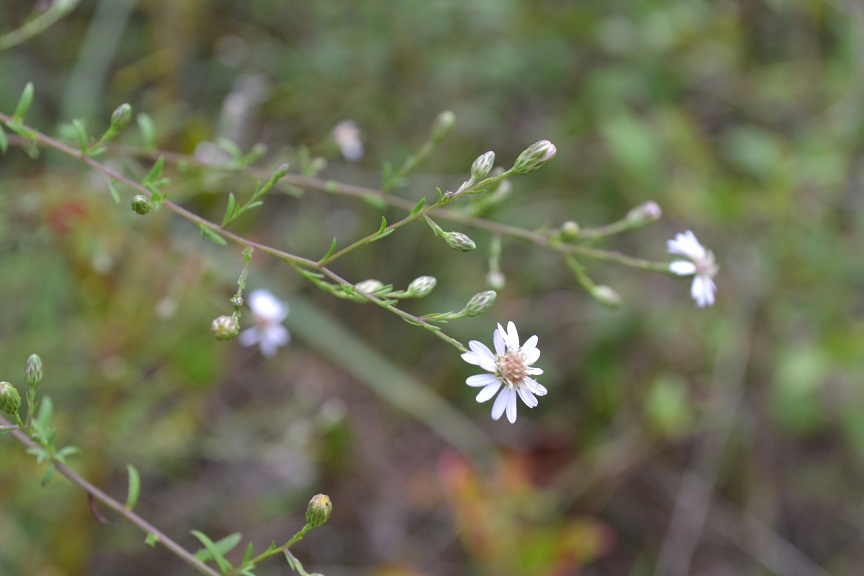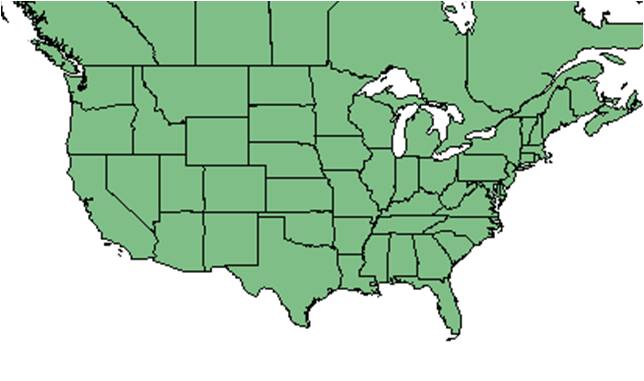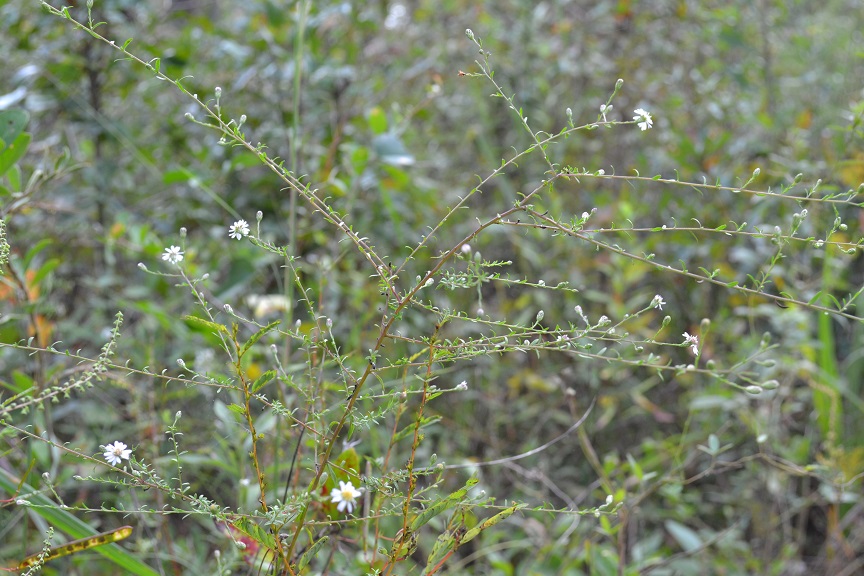Difference between revisions of "Conyza canadensis"
(→Distribution) |
|||
| Line 29: | Line 29: | ||
==Distribution== | ==Distribution== | ||
| − | ''Conyza canadensis'' var. ''canadensis'' is widespread, distributed from south Canada throughout the United States and into tropical America, whereas ''C. canadensis'' var. ''pusilla'' is distributed from southeast Massachusetts and Connecticut to south Indiana, down to Florida and Texas as well as into tropical America.<ref name= "Weakley">Weakley, A. S. (2015). Flora of the Southern and Mid-Atlantic States. Chapel Hill, NC, University of North Carolina Herbarium.</ref> | + | Generally, ''C. canadensis'' is native across North America, from the continental United States to most of Canada. It is also native to Navassa Island, Puerto Rico, St. Pierre and Miquelon, and the U.S. Virgin Islands. The species has been introduced to Alaska, Hawaii, and the Pacific Basin.<ref name= "USDA">USDA, NRCS. (2016). The PLANTS Database (http://plants.usda.gov, 15 April 2019). National Plant Data Team, Greensboro, NC 27401-4901 USA.</ref> ''Conyza canadensis'' var. ''canadensis'' is widespread, distributed from south Canada throughout the United States and into tropical America, whereas ''C. canadensis'' var. ''pusilla'' is distributed from southeast Massachusetts and Connecticut to south Indiana, down to Florida and Texas as well as into tropical America.<ref name= "Weakley">Weakley, A. S. (2015). Flora of the Southern and Mid-Atlantic States. Chapel Hill, NC, University of North Carolina Herbarium.</ref> |
==Ecology== | ==Ecology== | ||
Revision as of 18:02, 15 April 2019
| Conyza canadensis | |
|---|---|

| |
| Photo taken by Kevin Robertson | |
| Scientific classification | |
| Kingdom: | Plantae |
| Division: | Magnoliophyta - Flowering plants |
| Class: | Magnoliopsida - Dicotyledons |
| Order: | Asterales |
| Family: | Asteraceae ⁄ Compositae |
| Genus: | Conyza |
| Species: | C. canadensis |
| Binomial name | |
| Conyza canadensis (L.) Cronquist | |

| |
| Natural range of Conyza canadensis from USDA NRCS Plants Database. | |
Common name: Canadian Horseweed; Common Horseweed
Contents
Taxonomic notes
Synonyms: Erigeron canadensis Linnaeus; Leptilon canadense (Linnaeus) Britton; Erigeron pusillus Nuttall; Leptilon pusillum (Nuttall) Britton; Conyza parva Cronquist; Conyza canadensis var. glabrata (A. Gray) Cronquist; C. parva Cronquist; Erigeron canadensis var. pusillus (Nuttall) B. Boivin The Flora of North America.
Varieties: Conyza canadensis (Linnaeus) Cronquist var. canadensis; Conyza canadensis (Linnaeus) Cronquist var. pusilla (Nuttall) Cronquist
Description
A description of Conyza canadensis is provided in The Flora of North America.
Distribution
Generally, C. canadensis is native across North America, from the continental United States to most of Canada. It is also native to Navassa Island, Puerto Rico, St. Pierre and Miquelon, and the U.S. Virgin Islands. The species has been introduced to Alaska, Hawaii, and the Pacific Basin.[1] Conyza canadensis var. canadensis is widespread, distributed from south Canada throughout the United States and into tropical America, whereas C. canadensis var. pusilla is distributed from southeast Massachusetts and Connecticut to south Indiana, down to Florida and Texas as well as into tropical America.[2]
Ecology
Habitat
It can be found in a range of habitats from old fields to dunes as well as gardens and disturbed areas.[2]
Phenology
C. canadensis has been observed to flower in June.[3] Flowering season of C. canadensis var. canadensis is from July to November while flowering season of C. canadensis var. pusilla is from July to December as well as occasionally May to December.[2]
Seed dispersal
This species is thought to be dispersed by wind. [4]
Seed bank and germination
C. canadensis was found in the seed bank of scrub, longleaf pine, and ecotone habitats in the western panhandle region of Florida. [5]
Pollination
The following Hymenoptera families and species were observed visiting flowers of Conyza canadensis at Archbold Biological Station. [6]
Andrenidae: Andrena fulvipennis
Apidae: Epeolus carolinus
Halictidae: Sphecodes heraclei
Leucospididae: Leucospis affinis
Pompilidae: Episyron conterminus posterus
Sphecidae: Anacrabro ocellatus, Cerceris blakei, Ectemnius rufipes ais, Microbembex monodonta, Pluto rufibasis, Tachysphex apicalis, T. similis
Vespidae: Pachodynerus erynnis, Parancistrocerus salcularis rufulus, Stenodynerus beameri, S. fundatiformis, S. histrionalis rufustus
Conservation and management
Cultivation and restoration
Photo Gallery
References and notes
- ↑ USDA, NRCS. (2016). The PLANTS Database (http://plants.usda.gov, 15 April 2019). National Plant Data Team, Greensboro, NC 27401-4901 USA.
- ↑ 2.0 2.1 2.2 Weakley, A. S. (2015). Flora of the Southern and Mid-Atlantic States. Chapel Hill, NC, University of North Carolina Herbarium.
- ↑ Nelson, G. PanFlora: Plant data for the eastern United States with emphasis on the Southeastern Coastal Plains, Florida, and the Florida Panhandle. www.gilnelson.com/PanFlora/ Accessed: 8 DEC 2016
- ↑ Kirkman, L. Katherine. Unpublished database of seed dispersal mode of plants found in Coastal Plain longleaf pine-grasslands of the Jones Ecological Research Center, Georgia.
- ↑ Ruth, A. D., et al. 2008. Seed bank dynamics of sand pine scrub and longleaf pine flatwoods of the Gulf Coastal Plain (Florida). Ecological Restoration 26:19-21.
- ↑ Deyrup, M.A. and N.D. 2015. Database of observations of Hymenoptera visitations to flowers of plants on Archbold Biological Station, Florida, USA.
